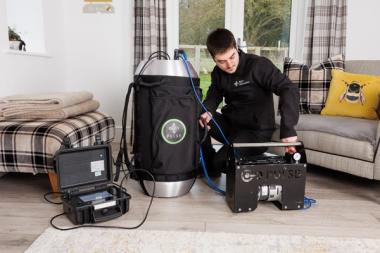Article
Overheating in homes: Using SmartHTC, Pulse, and ACIN VentiFlow to predict and prevent the risk
The UK’s climate is changing — and our housing needs to catch up. With hotter, longer summers now a regular reality, overheating in homes is a serious and growing issue. Poor ventilation, lack of shading, and inadequate understanding of whole-building performance mean many retrofitted properties are at risk of becoming uncomfortably — or even dangerously — hot.

At Build Test Solutions, we provide assessors, designers, and housing providers with the tools to address this risk at its root. Our integrated suite of technologies — SmartHTC, Pulse, and ACIN VentiFlow — allows you to measure thermal performance, assess ventilation systems, and test airtightness in real-world conditions. This data-driven approach is vital for identifying overheating risk early and delivering smarter, safer retrofits.
Why Overheating Is a Growing Problem
As the climate changes and we experience periods of extended hot weather, buildings and occupants must adapt. Overheating is especially common when:
- Buildings are airtight without adequate ventilation
- Solar gains accumulate in highly glazed and poorly shaded spaces like loft conversions and top-floor flats
- Mechanical ventilation systems are underperforming or incorrectly commissioned
- Retrofit upgrades are made without considering summertime comfort
The effects range from sleep disruption and poor indoor air quality to severe health impacts for vulnerable occupants. The Climate Change Committee warns that overheating risk in UK homes could quadruple by 2050 if left unaddressed.
SmartHTC: Measuring True Heat Transfer
SmartHTC provides a measured view of how a home retains or loses heat by calculating its heat transfer coefficient (HTC). Using passive monitoring of internal temperatures and energy consumption, SmartHTC gives a real-world, whole-building measurement — no assumptions, just evidence.
The internal temperature data can also be used to calculate the extent of overheating in dwellings according to CIBSE TM52. This is more complicated than just observing the temperature, humans are adaptable, and that means that they can cope with higher temperatures given a few days to adjust, but cope much worse with a sudden temperature swing. Tracking the occurrence of overheating provides the information needed to make informed decisions.

Why this matters for overheating:
Low HTC = heat transfer is low. This is great for winter, but good for summer too, keeping out the heat during the middle of the day. It’s essential, though, that this is paired with a good ventilation strategy, with lots of ventilation overnight when it’s cooler outside.
SmartHTC empowers retrofit designers and housing providers to understand the thermal balance of each home, and to make informed decisions about insulation, glazing, shading, and ventilation strategies.
ACIN Ventiflow: Measuring Ventilation Performance
Assessing ventilation isn’t just about checking what’s installed — it’s about measuring what’s actually working.
Build Test Solutions is one of the premier UK resellers of ACIN’s VentiFlow tools, which provide precise airflow measurements for:
- Mechanical Extract Ventilation (MEV) and MVHR systems
- Kitchen and bathroom fans
- Supply and extract grills in low-energy buildings
The FlowFinder Capture Hood and VentiFlow instruments are essential for diagnosing underperforming systems that could contribute to overheating by failing to remove internal heat gains.

Pulse: Quantifying Background Ventilation and Airtightness
One of the most overlooked factors in overheating is background ventilation — the passive airflow through a home via trickle vents, cracks, and construction gaps. While essential for fresh air, poor background ventilation can trap heat and humidity indoors during warm weather.
This is where Pulse, our low-pressure airtightness test device, comes in.
Pulse measures air permeability at pressures representative of natural conditions (around 4 Pa) — giving you an accurate picture of how air moves through the building envelope in day-to-day life.
With Pulse, you can:
- Assess whether natural ventilation is sufficient to mitigate overheating risk
- Check that the airtightness is sufficiently low where the mechanical ventilation design demands it
- Quantify the impact of retrofit interventions like draft-proofing or new glazing
- Balance airtightness with indoor air quality to meet both energy and comfort goals
Used alongside SmartHTC and VentiFlow, Pulse fills in the final piece of the overheating puzzle: how much air passes into the building when windows are closed — such as at night, in urban areas, or properties with security concerns.

An Integrated Approach to Retrofit and Comfort
When used together, SmartHTC, Pulse, and ACIN VentiFlow provide a complete picture of how a building performs — not just in the heating season, but all year round.
With this data, you can:
- Identify homes at risk of overheating early
- Design retrofits that balance efficiency with summer comfort
- Confirm that ventilation systems are delivering adequate airflow
- Measure airtightness and background ventilation to inform passive cooling strategies
- Avoid unintended consequences like trapped heat or reliance on portable AC units
Conclusion: Retrofit for Resilience, Not Just Efficiency
Overheating isn’t just a summer discomfort — it’s a building safety issue that’s only going to get worse. As we push toward net zero, we must ensure that energy efficiency upgrades don’t compromise occupant health and comfort.
At Build Test Solutions, we’re equipping the industry with the tools to retrofit smarter:
- SmartHTC for measured thermal performance
- ACIN Ventiflow for accurate ventilation diagnostics
- Pulse for real-world airtightness and background ventilation
Together, these technologies help you deliver homes that are cooler in summer, warmer in winter, and safer all year round.




